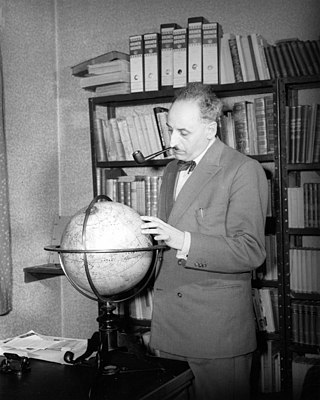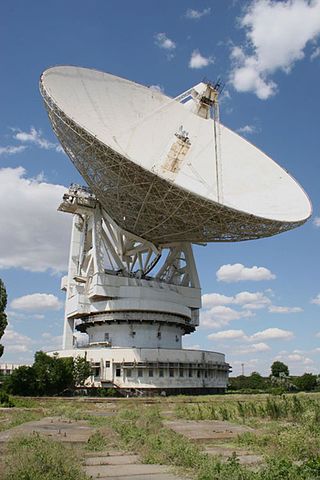Related Research Articles
The Fermi paradox is the discrepancy between the lack of conclusive evidence of advanced extraterrestrial life compared to the apparently high a priori likelihood of its existence. As a 2015 article put it, "If life is so easy, someone from somewhere must have come calling by now."
Lincos is a constructed language first described in 1960 by Dr. Hans Freudenthal in his book Lincos: Design of a Language for Cosmic Intercourse, Part 1. It is a language designed to be understandable by any possible intelligent extraterrestrial life form, for use in interstellar radio transmissions. Freudenthal considered that such a language should be easily understood by beings not acquainted with any Earthling syntax or language. Lincos was designed to be capable of encapsulating "the whole bulk of our knowledge".

The search for extraterrestrial intelligence (SETI) is a collective term for scientific searches for intelligent extraterrestrial life, for example, monitoring electromagnetic radiation for signs of transmissions from civilizations on other planets.

Frank Donald Drake was an American astrophysicist and astrobiologist.

Hans Freudenthal was a Jewish-German-born Dutch mathematician. He made substantial contributions to algebraic topology and also took an interest in literature, philosophy, history and mathematics education.

The communication with extraterrestrial intelligence (CETI) is a branch of the search for extraterrestrial intelligence (SETI) that focuses on composing and deciphering interstellar messages that theoretically could be understood by another technological civilization. The best-known CETI experiment of its kind was the 1974 Arecibo message composed by Frank Drake.
Alien languages, i.e. languages of extraterrestrial beings, are a hypothetical subject since none have been encountered so far. The research in these hypothetical languages is variously called exolinguistics, xenolinguistics or astrolinguistics. The question of what form alien languages might take and the possibility for humans to recognize and translate them has been part of the linguistics and language studies courses, e.g., at the Bowling Green State University (2001).

The Teen Age Message (TAM) was a series of interstellar radio transmissions sent from the Yevpatoria Planetary Radar to six solar-type stars during August–September 2001. The structure of the TAM was suggested by Alexander Zaitsev, Chief Scientist at Russia's Institute of Radio-engineering and Electronics. The message's content and target stars were selected by a group of teens from four Russian cities, who collaborated in person and via the Internet. Each transmission comprised three sections: a sounding, a live theremin concert, and digital data including images and text. TAM was humanity's fourth Active SETI broadcast and the first musical interstellar radio message.

Aleksandr Leonidovich Zaitsev was a Russian and Soviet radio engineer and astronomer from Fryazino. He worked on radar astronomy devices, near-Earth asteroid radar research, and SETI.
Active SETI is the attempt to send messages to intelligent extraterrestrial life. Active SETI messages are predominantly sent in the form of radio signals. Physical messages like that of the Pioneer plaque may also be considered an active SETI message. Active SETI is also known as METI.
Allen Tough was a Canadian educator and researcher. Widely known as a futurist, scientist, and author, Tough was Professor Emeritus at the University of Toronto at the time of his death. He made major contributions to the fields of Adult Education, Futures Studies, and SETI. Linking these fields together was Tough's concern with the long-term future of humanity in the cosmos, and human kind's search for meaning and purpose on personal, societal, and global levels. He taught at the Ontario Institute for Studies in Education (OISE), University of Toronto, for 33 years, retiring from teaching in 1997. After his retirement he devoted his time and energy to his research interests.

Cosmic Call was the name of two sets of interstellar radio messages that were sent from RT-70 in Yevpatoria, Ukraine in 1999 and 2003 to various nearby stars. The messages were designed with noise-resistant format and characters.
The cultural impact of extraterrestrial contact is the corpus of changes to terrestrial science, technology, religion, politics, and ecosystems resulting from contact with an extraterrestrial civilization. This concept is closely related to the search for extraterrestrial intelligence (SETI), which attempts to locate intelligent life as opposed to analyzing the implications of contact with that life.

JonkheerAlexander Ollongren is a professor emeritus at Leiden University. He serves on the Advisory Council of METI.
Breakthrough Initiatives is a science-based program founded in 2015 and funded by Julia and Yuri Milner, also of Breakthrough Prize, to search for extraterrestrial intelligence over a span of at least 10 years. The program is divided into multiple projects. Breakthrough Listen will comprise an effort to search over 1,000,000 stars for artificial radio or laser signals. A parallel project called Breakthrough Message is an effort to create a message "representative of humanity and planet Earth". The project Breakthrough Starshot, co-founded with Mark Zuckerberg, aims to send a swarm of probes to the nearest star at about 20% the speed of light. The project Breakthrough Watch aims to identify and characterize Earth-sized, rocky planets around Alpha Centauri and other stars within 20 light years of Earth. Breakthrough plans to send a mission to Saturn's moon Enceladus, in search for life in its warm ocean, and in 2018 signed a partnership agreement with NASA for the project.
Stéphane Dumas (1970–2016) was a Canadian physicist who, together with his colleague Yvan Dutil, has created a noise-resistant coding system for messages aimed at communicating with extraterrestrial civilization. This system was used in the creation of messages beamed towards close stars from the Yevpatoria RT-70 radio telescope in Ukraine in 1999 and 2003.
METI International, known simply as METI, is a non-profit research organization founded in July 2015 by Douglas Vakoch that creates and transmits interstellar messages to attempt to communicate with extraterrestrial civilizations. It is based in San Francisco, California.
Wolf Lvovich Gordin, also known as Beoby/Beobi, was an anarchist and the creator of a constructed language called AO.

Douglas A. Vakoch is an American astrobiologist, search for extraterrestrial intelligence (SETI) researcher, psychologist, and president of METI International, a nonprofit research and educational organization devoted to transmitting intentional signals to extraterrestrial civilizations. Vakoch led METI's participation in Sónar Calling GJ 273b, which transmitted a series of interstellar messages to Luyten's Star, located 12.4 light years from Earth. Vakoch advocates ongoing transmission projects, arguing that this does not increase risks of an alien invasion as suggested by British cosmologist Stephen Hawking. He has participated in several SETI observation programs, and after sixteen years at the SETI Institute, where he was director of Interstellar Message Composition, Vakoch founded METI International. He has edited over a dozen books in SETI, astrobiology, the psychology of space exploration, and ecocriticism. He is general editor of two-book series in ecocriticism and in the intersection of space and society. Vakoch has appeared widely on television and radio as a commentator on SETI and astrobiology. He is an emeritus professor of clinical psychology at the California Institute of Integral Studies (CIIS).

The following outline is provided as an overview of and topical guide to extraterrestrial life:
References
- ↑ Oberhaus, Daniel (2019-10-22). Extraterrestrial Languages. MIT Press. ISBN 978-0-262-04306-9. OCLC 1142708941.
- ↑ Wolf Gordin, Grammatika logicheskogo yazyka AO [Grammar of the Language AO] (1924) (Russian)
- ↑ Smith, Michael G. (2014-12-01). Rockets and Revolution: A Cultural History of Early Spaceflight. U of Nebraska Press. p. 130. ISBN 978-0-8032-8656-6. OCLC 1109730256.
- ↑ (in French) Kuznecov S. Linguistica cosmica: La naissance du paradigme cosmique // Une familière étrangeté: La linguistique russe et soviétique. Paris, 1995 (Histoire Épistémologie Langage. 17/11 (Tome XVII – fascicule 2)), pp. 211–234.
- ↑ (in Russian)Kuznetsov, Sergei N. (2014). "Linguistica cosmica: rozhdeniye 'kosmicheskoy paradigmy'". Sovremennaya Nauka (2): 59–60. (The updated version of Kuznetsov's 1995 French-language article)
- ↑ "Mission" . Retrieved 8 December 2019.
- ↑ Dunér, David; Persson, Erik; Holmberg, Gustav (2013-09-26). The History and Philosophy of Astrobiology: Perspectives on Extraterrestrial Life and the Human Mind. Cambridge Scholars Publishing. p. 203. ISBN 978-1-4438-5302-6. OCLC 942487127.
- ↑ Ollongren, Alexander (2012-11-27). Astrolinguistics: Design of a Linguistic System for Interstellar Communication Based on Logic. Springer Science & Business Media. p. 128. ISBN 978-1-4614-5468-7. OCLC 939853829.